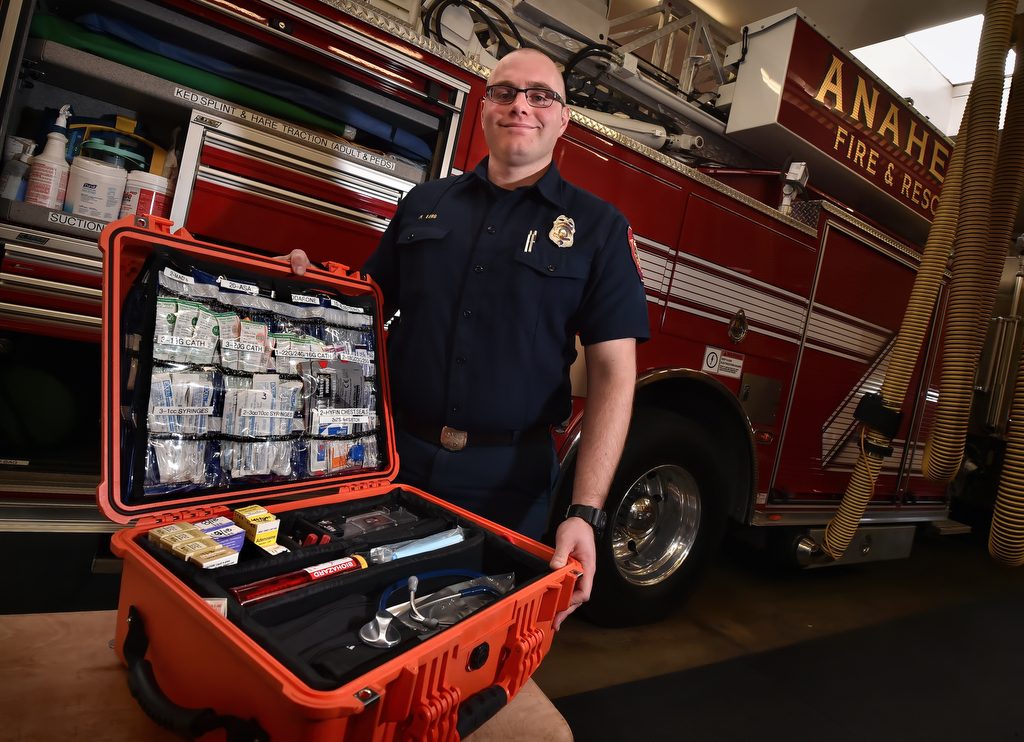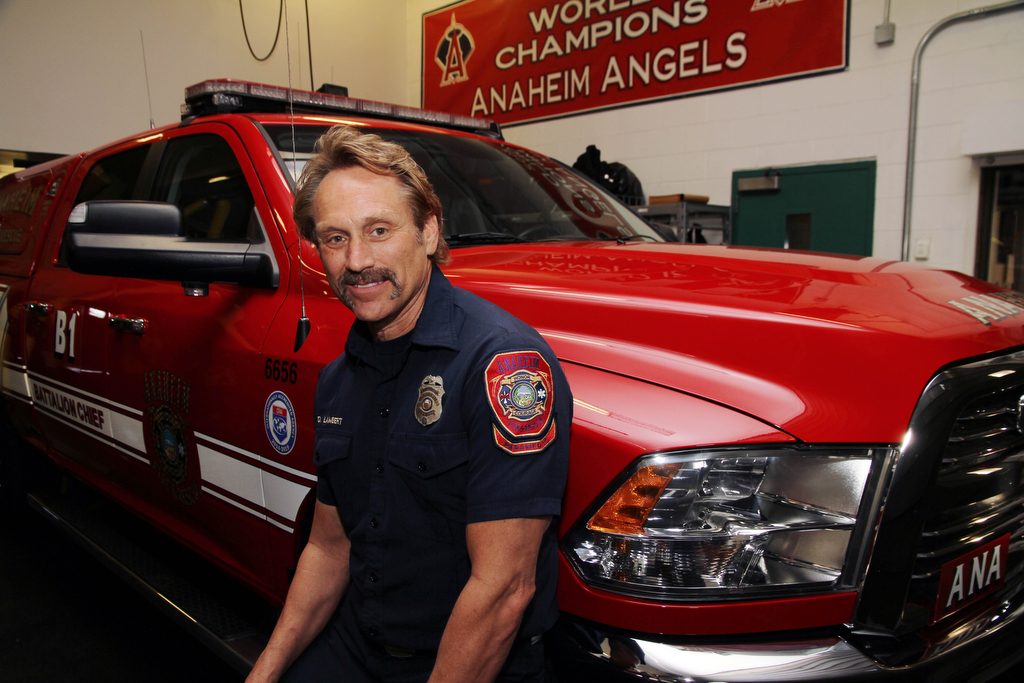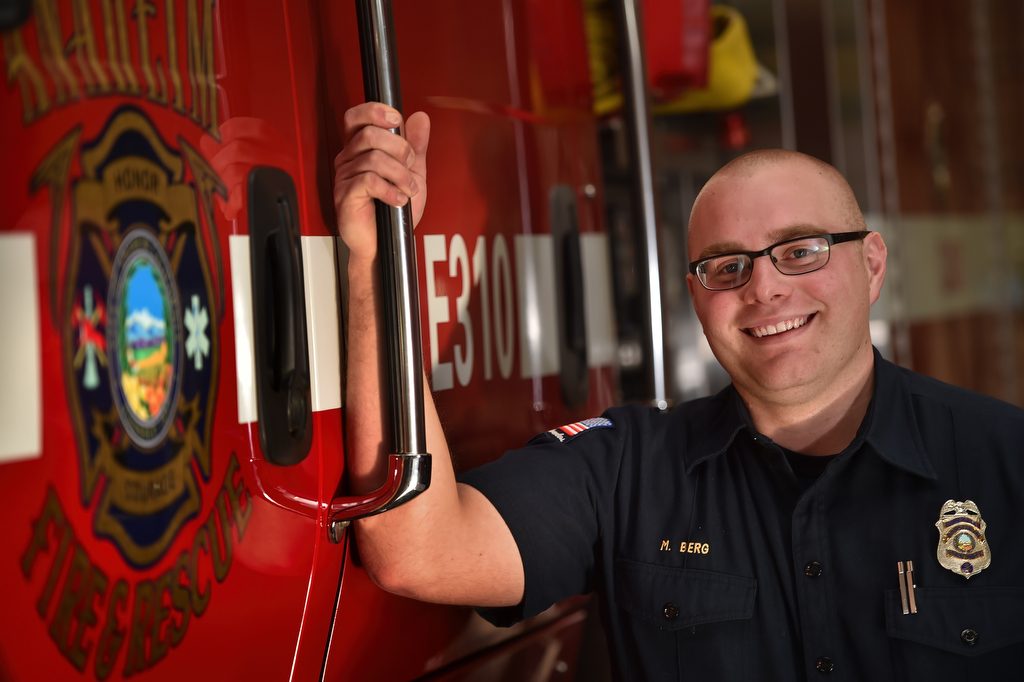It’s been more than three decades since senior firefighter and paramedic Daniel Lambert, 58, joined Anaheim Fire & Rescue.
But though the world has changed, some things are constant — such as the camaraderie between firefighters and their desire to make a difference.
“It is a good feeling being able to make a positive impact in someone’s life,” said Anaheim Fire & Rescue rookie Marshall Berg, 23. “Something my dad always used to tell me: Leave a wake of happiness everywhere you go. It’s something that’s stayed with me.”

Anaheim Fire & Rescue Probationary Firefighter/Paramedic Marshall Berg shows a medical drug box that contains advance life support medications such as epinephrine, drugs for cardiac arrest, pain management drugs, drugs for overdoses, and saline bags.
Photo by Steven Georges/Behind the Badge OC.
Berg is fulfilling a lifelong dream and following in the footsteps of his father and older brother by joining the ranks of Anaheim Fire & Rescue. He graduated high school early to join the fire academy, and Anaheim Fire & Rescue was his top choice for employment.
“It’s the best department in the nation,” Berg said.
At Station 10, Berg is up early making his bed, brewing coffee, and setting the newspaper on the table. Rookies are responsible for taking care of the station. It’s one way to prove they’re reliable and that the other firefighters can count on them.
Though Lambert plans to retire this year and his rookie days are long gone, his mornings are similar: his bed is made by 8 a.m. and he still helps keep the station clean.

Anaheim Fire & Rescue Firefighter/Paramedic Daniel Lambert is also a tactical paramedic with the SWAT team.
Photo by Janine Swiatkowski/Behind the Badge OC.
“One good thing about working with young people is it keeps me young too, I guess,” said Lambert, who’s a tactical paramedic with the SWAT team and the longest-serving Anaheim Fire & Rescue employee, with 32 years of service.
When Lambert was hired in 1986, firefighters shared one station phone to call their families.
Berg, who’s nine months into his probationary period, remembers receiving calls from the station for nightly talks with his father, Scott, now retired from Anaheim Fire & Rescue.
“If it was busy, you didn’t talk to them,” Lambert said, “or maybe you could talk to them for just a couple minutes because there are eight other guys behind you wanting to talk to their family. Now, no one ever uses the station phone.”
Back then, fire engines had open cabs that exposed firefighters to rain, heat, and the loud sounds of the siren.
“It definitely would be cool to have the open cabs or ride a tail board,” Berg said, “but I’m definitely happy there’s progress in the fire service.”

Anaheim Fire & Rescue Probationary Firefighter/Paramedic Marshall Berg at Station 10.
Photo by Steven Georges/Behind the Badge OC.
Huge advances have also been made in medicine and medical technology. For one, cardiac monitors are smaller and do more, Lambert said. Anaheim Fire & Rescue plans to replace its current monitors with newer models that send readings directly to the fire company’s iPads. The Anaheim Fire & Rescue has been using iPads since 2013, said Captain/Paramedic Dave Barry, the department’s emergency medical services (EMS) coordinator.
“Everything’s kind of following the cell phone,” Lambert said. “Originally, the cell phones were these huge things. Now it’s the same with our radios.”

Anaheim Fire & Rescue Firefighter/Paramedic Daniel Lambert has seen the number of calls for service increase greatly over his three decades working in Anaheim.
Photo by Janine Swiatkowski/Behind the Badge OC.
“There was only one radio on our rig when I got first hired on,” he said. “The captain had that on him all the time. It was a big behemoth thing with this big long whip antenna. And now, every person has their own personal radio on the rig.”
Technology has also changed the way people learn and train.
“If we had a question, we either had to ask somebody about it or we had to go to a book and look it up,” Lambert said. “In order to find out how to work a tool or how to fix a tool, I would have to go to somebody that knew how to do that. Well, now the rookies can just go to YouTube and say, ‘How do I fix this type of chainsaw.'”
Today’s prospective firefighters receive at least eight weeks of firefighter training and two weeks of EMS training through Anaheim Fire & Rescue’s new recruit academy. Until the late 1990s, new firefighters received just two weeks of total training when they were hired, Barry said.
“It’s definitely stressful, but you put a lot of that stress on your own shoulders because you want to do well,” Berg said. “It’s not an easy thing. You have to train hard and really study and do your due diligence.”
“They need to demonstrate their ability to pull the hose correctly and put up the ladders correctly and that kind of thing,” Lambert agreed. “But then they also need to prove themselves.”

Anaheim Fire & Rescue Probationary Firefighter/Paramedic Marshall Berg talks about the support he received from fellow firefighters as he faces the challenges of becoming an Anaheim firefighter.
Photo by Steven Georges/Behind the Badge OC.
It’s imperative the firefighters work well together and trust one another. Since the late 1980s, their call load has increased from 12,000 to 14,000 calls per year to 38,655 calls in 2017, Barry said. The population of Anaheim has increased as well, from 267,388 in 1990 to 351,043 in 2016, according to the U.S. Census. And those numbers don’t account for Anaheim’s massive transient population — people traveling through the city on freeways or visiting the Honda Center, Anaheim Convention Center, Disneyland, or the city’s many other attractions.
“You have to have a good attitude and be willing to get along with the guys because we’re here for sometimes five days at a time all together,” Berg said. “It feels like half our time is spent here, so it’s kind of your family away from home.”
The fire stations have continued the holiday tradition, when firefighters’ families gather to celebrate with a meal at the station.
“When there was a holiday when I first got hired, all the families came down and everybody hung out at the stations during the day,” Lambert said. “Now, it’s not quite as involved… A lot of that evolved because of the amount of calls we have.”
At Station 10, the firefighters passed along another tradition — popcorn, also known as “making corn.”
The station has a dedicated popcorn pot, and firefighters do their best to pop every single kernel and not burn any.
“It’s a great thing when you can have fellowship around the table or camaraderie,” Berg said. “It’s kind of one of those fun traditions that brings back the nostalgia for the guys that are older and it’s something that’s kind of cool for the younger generation to continue.”
 Behind the Badge
Behind the Badge



